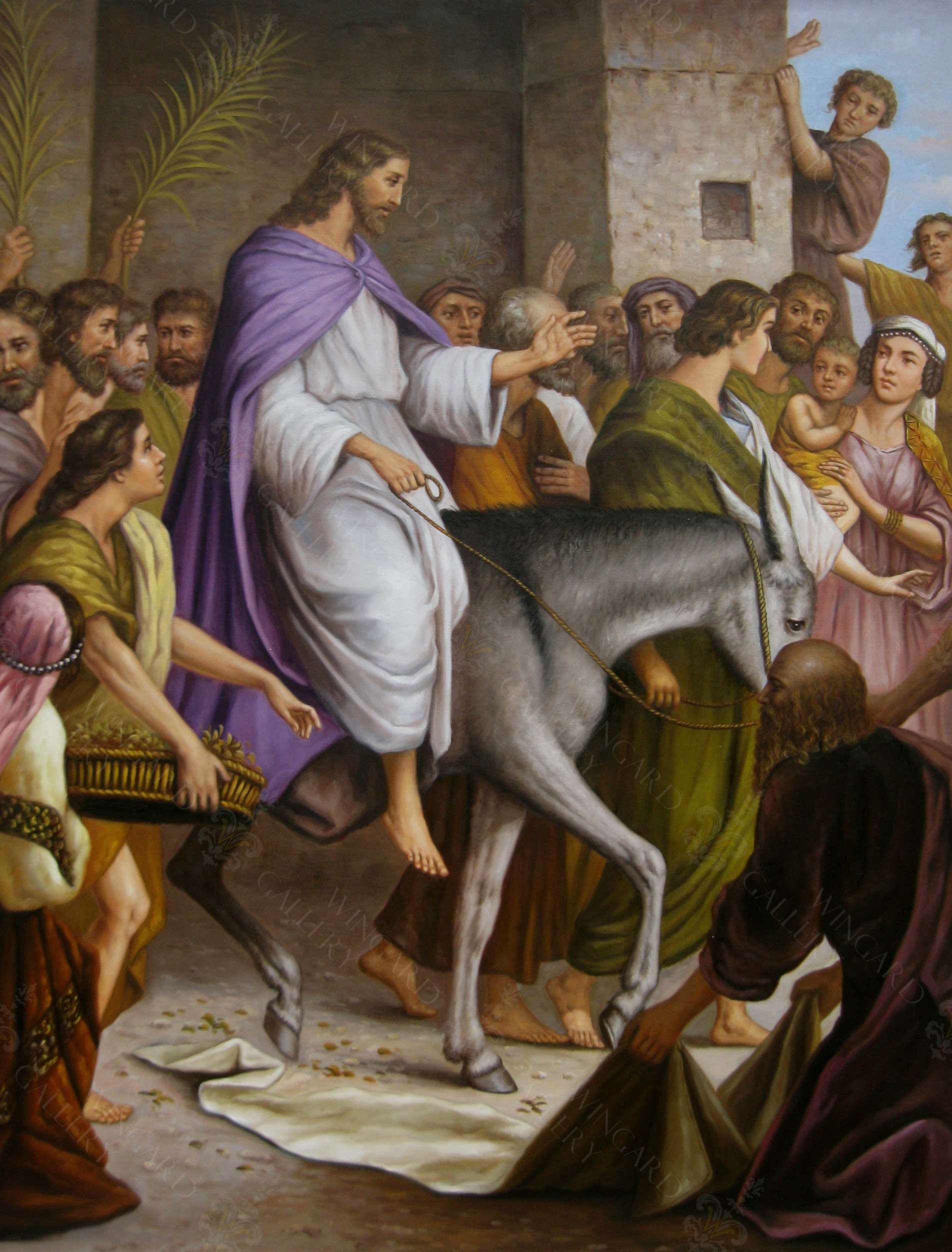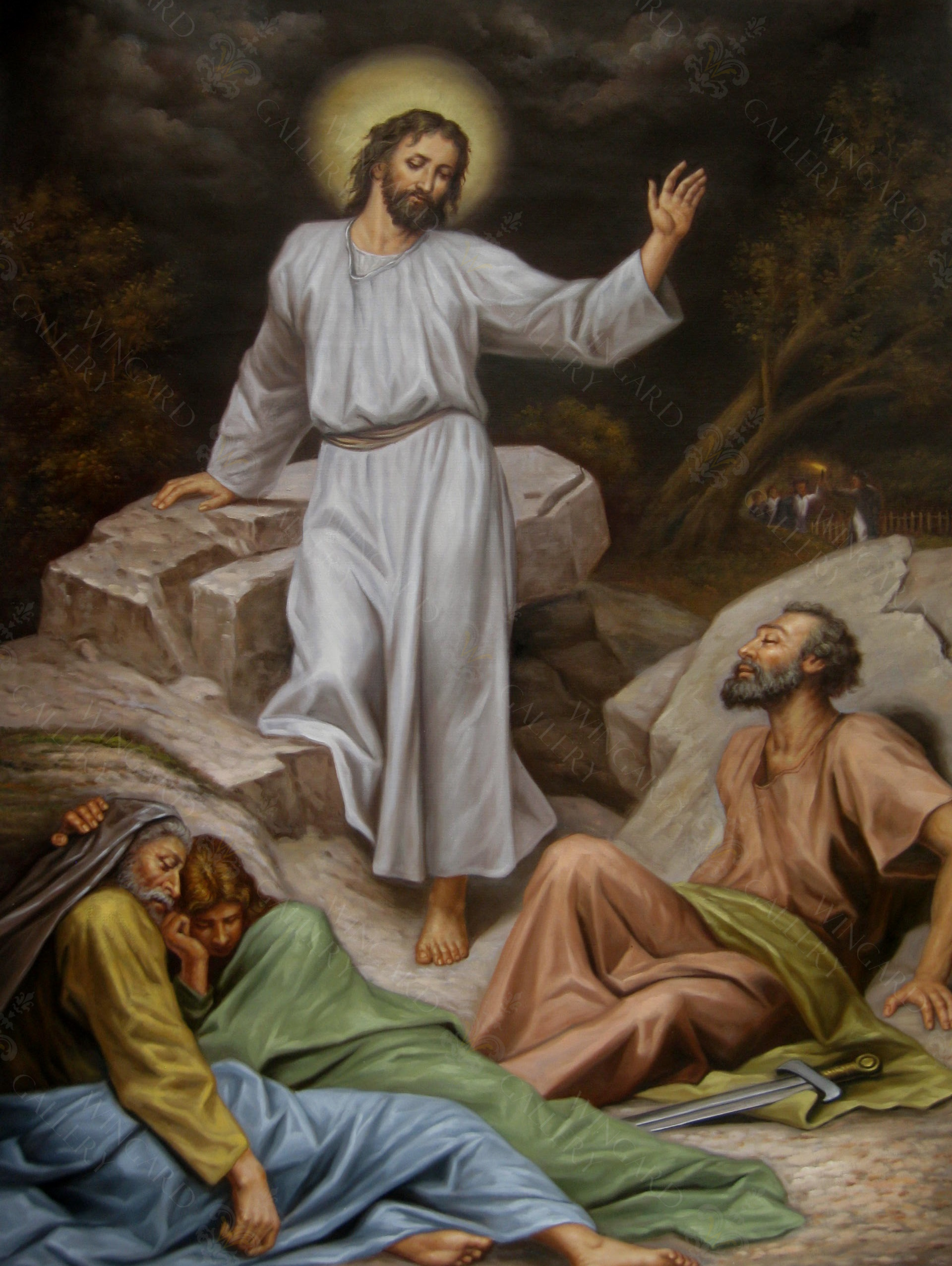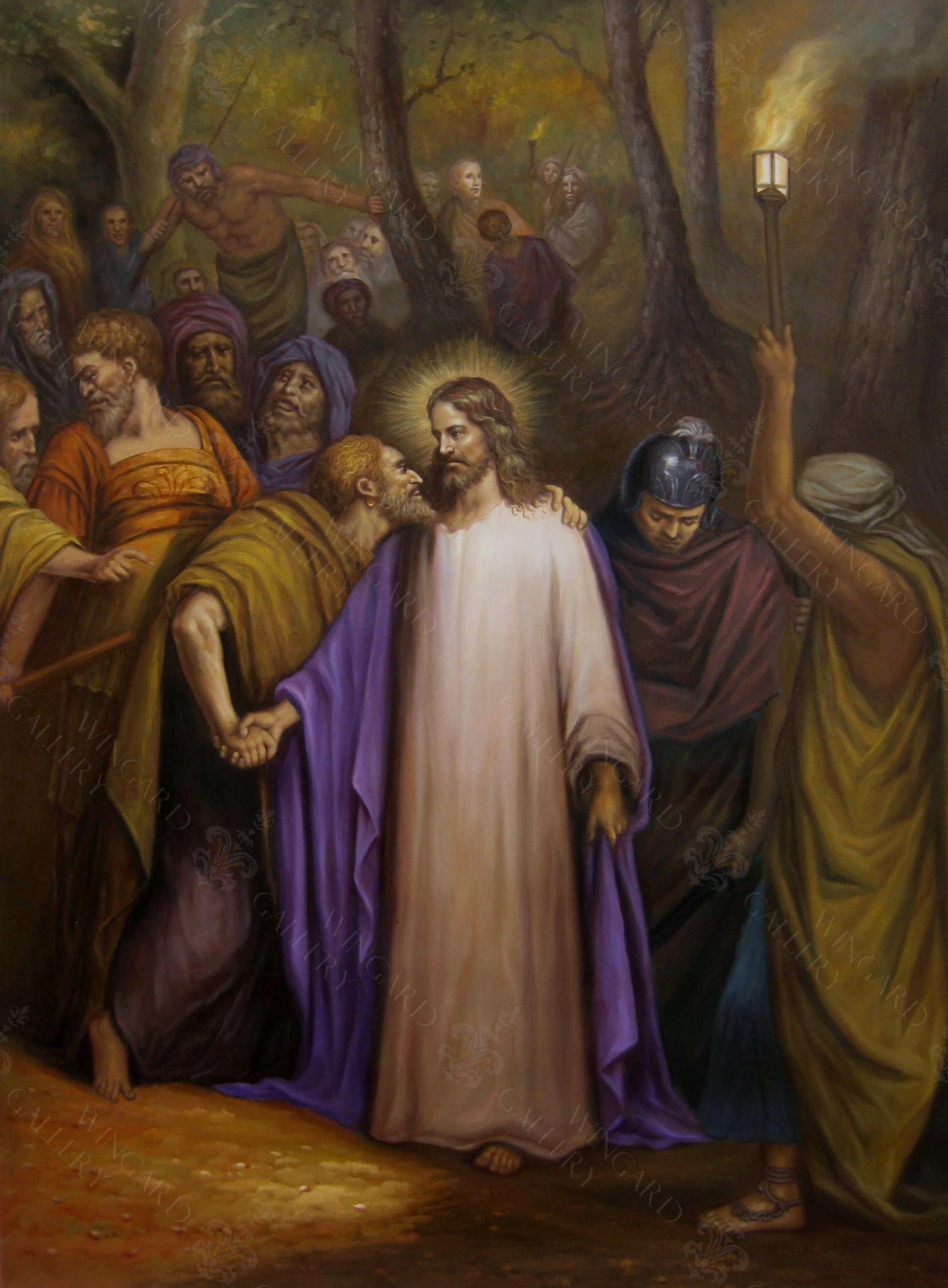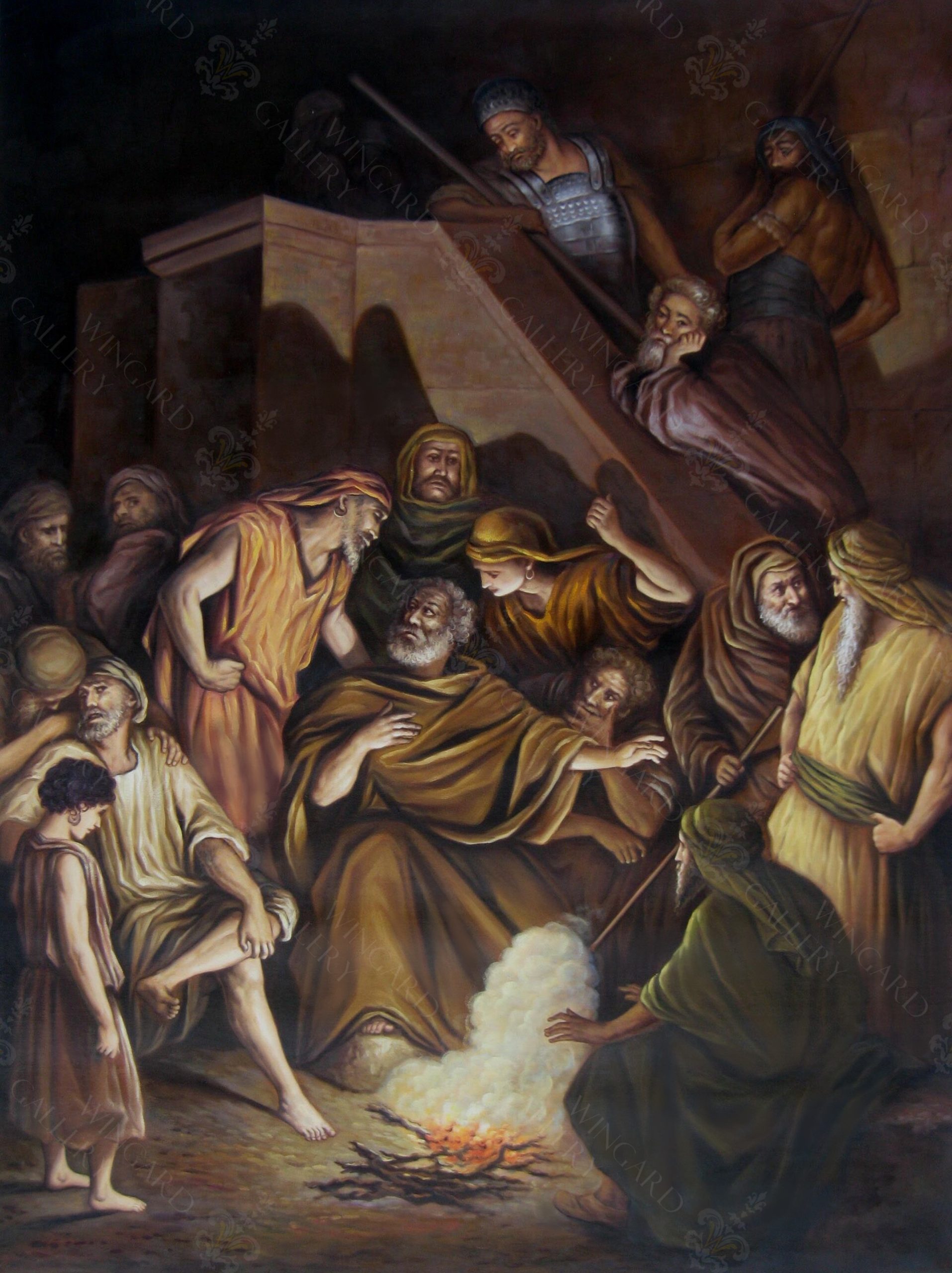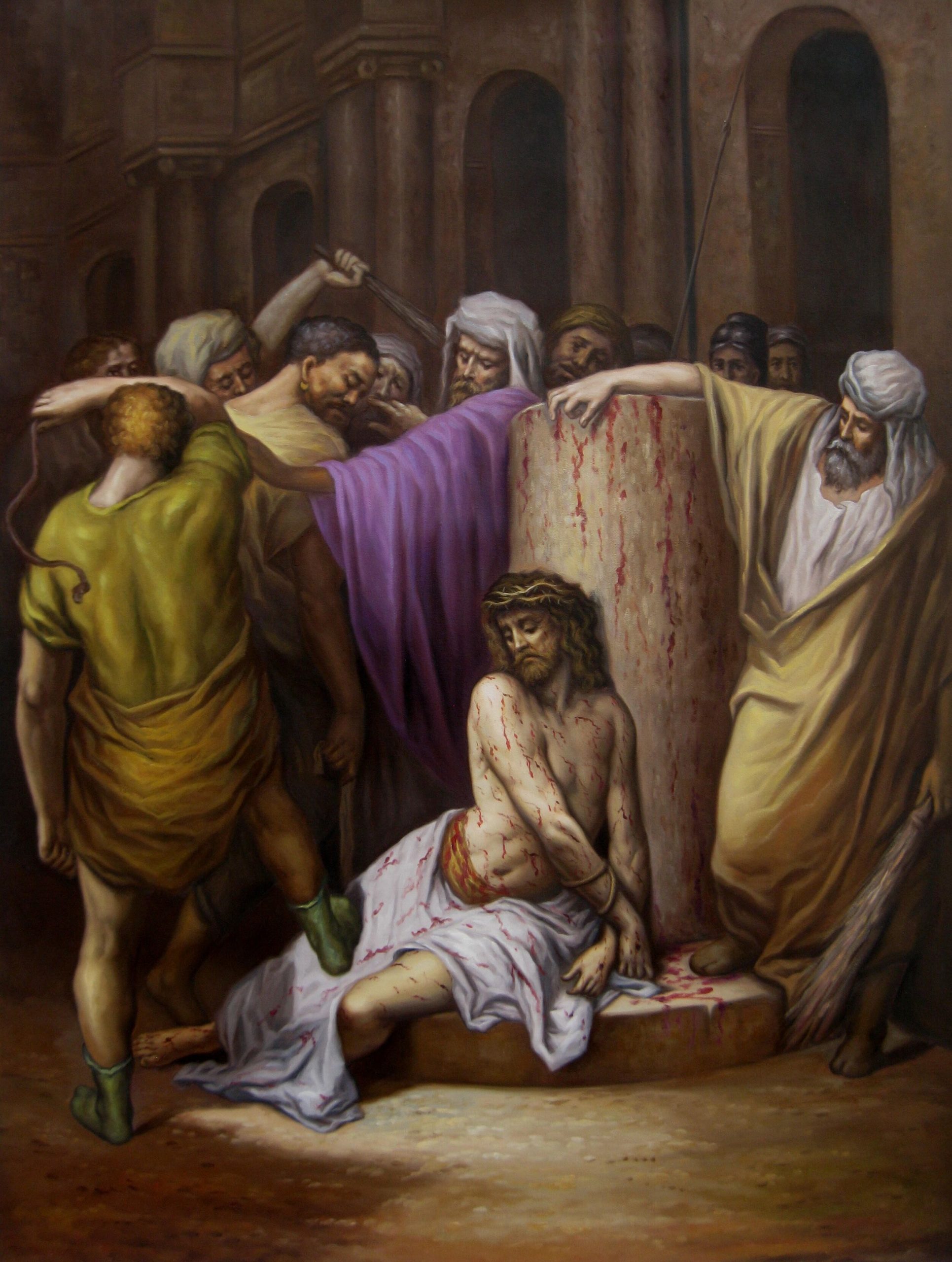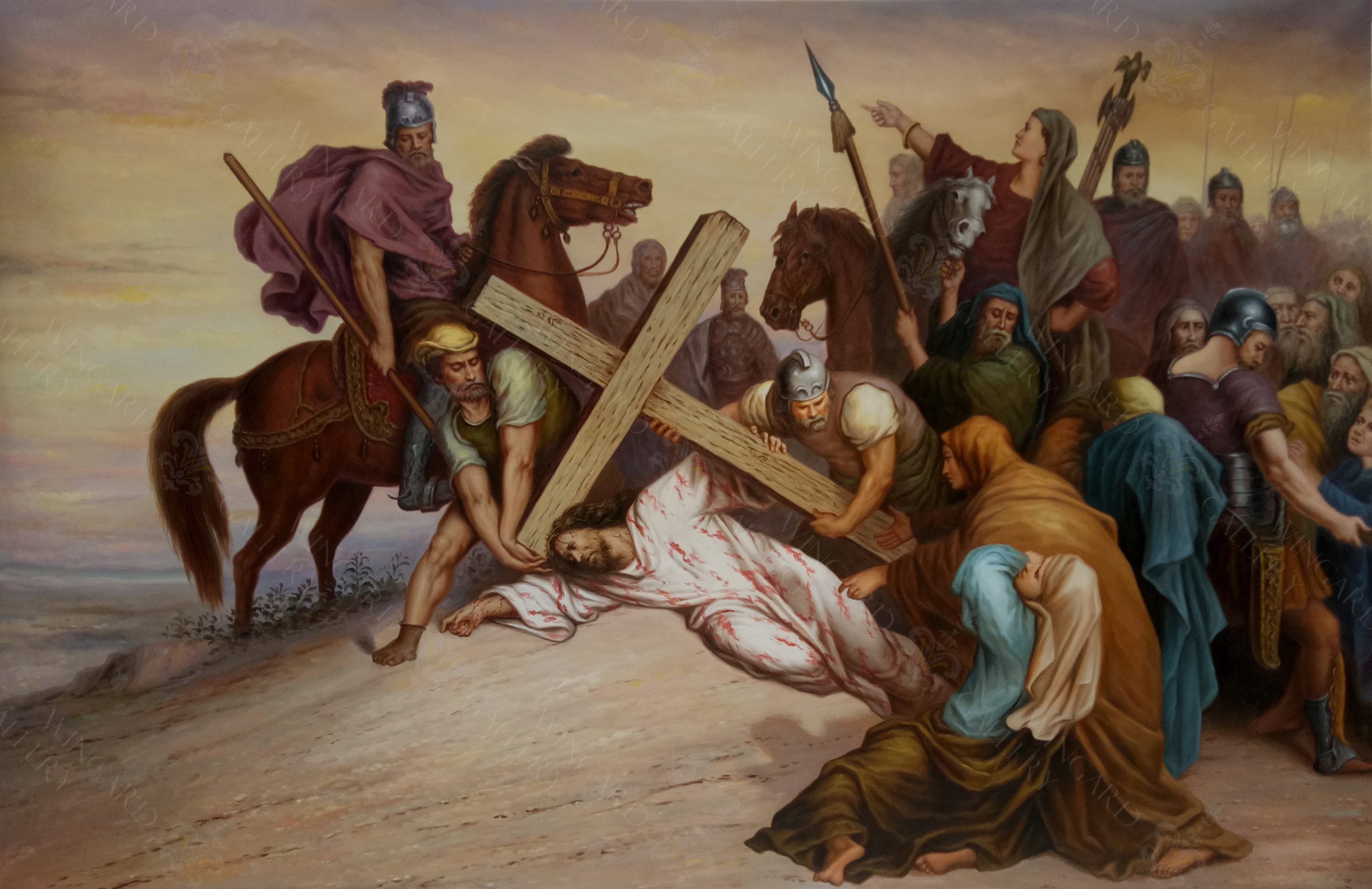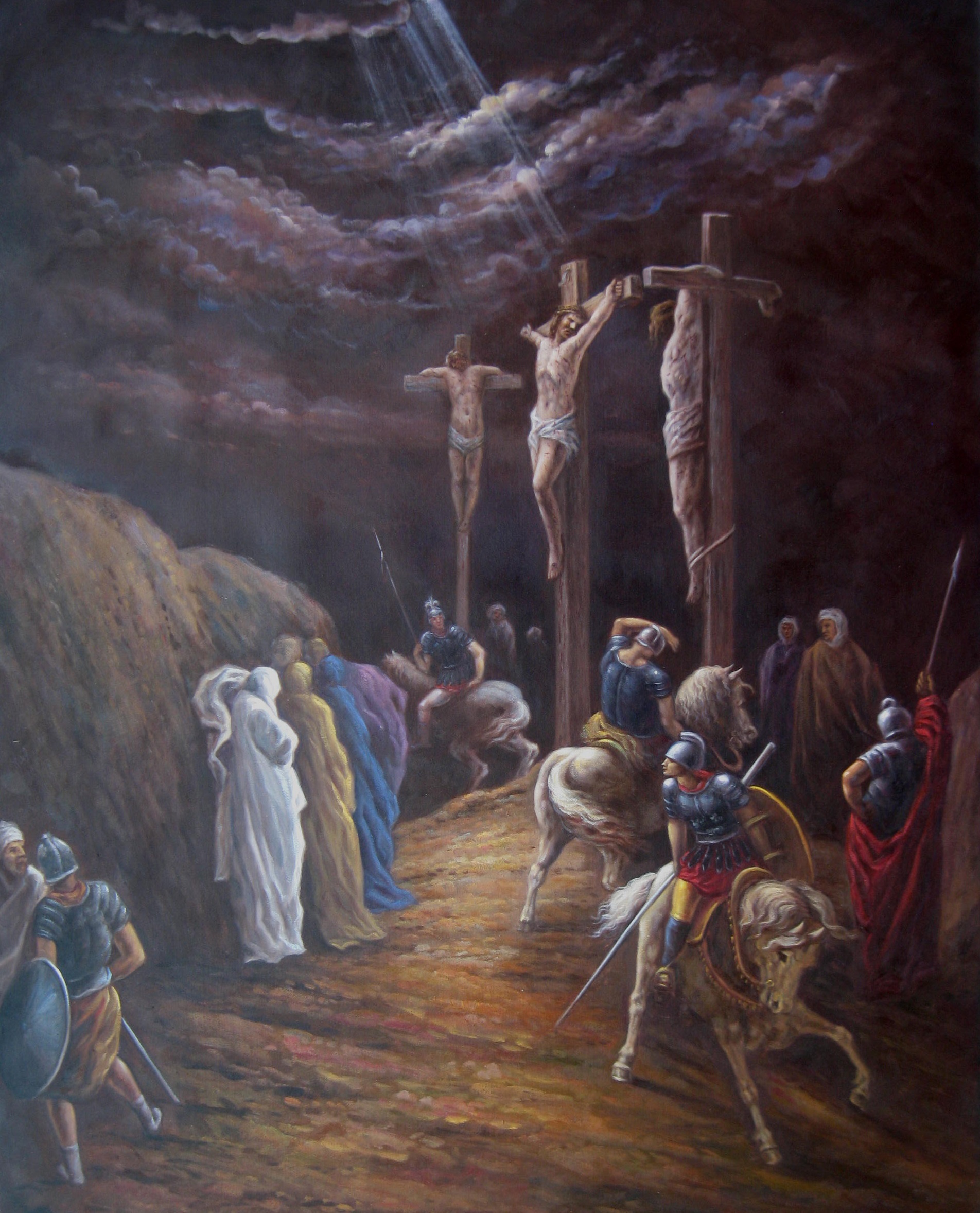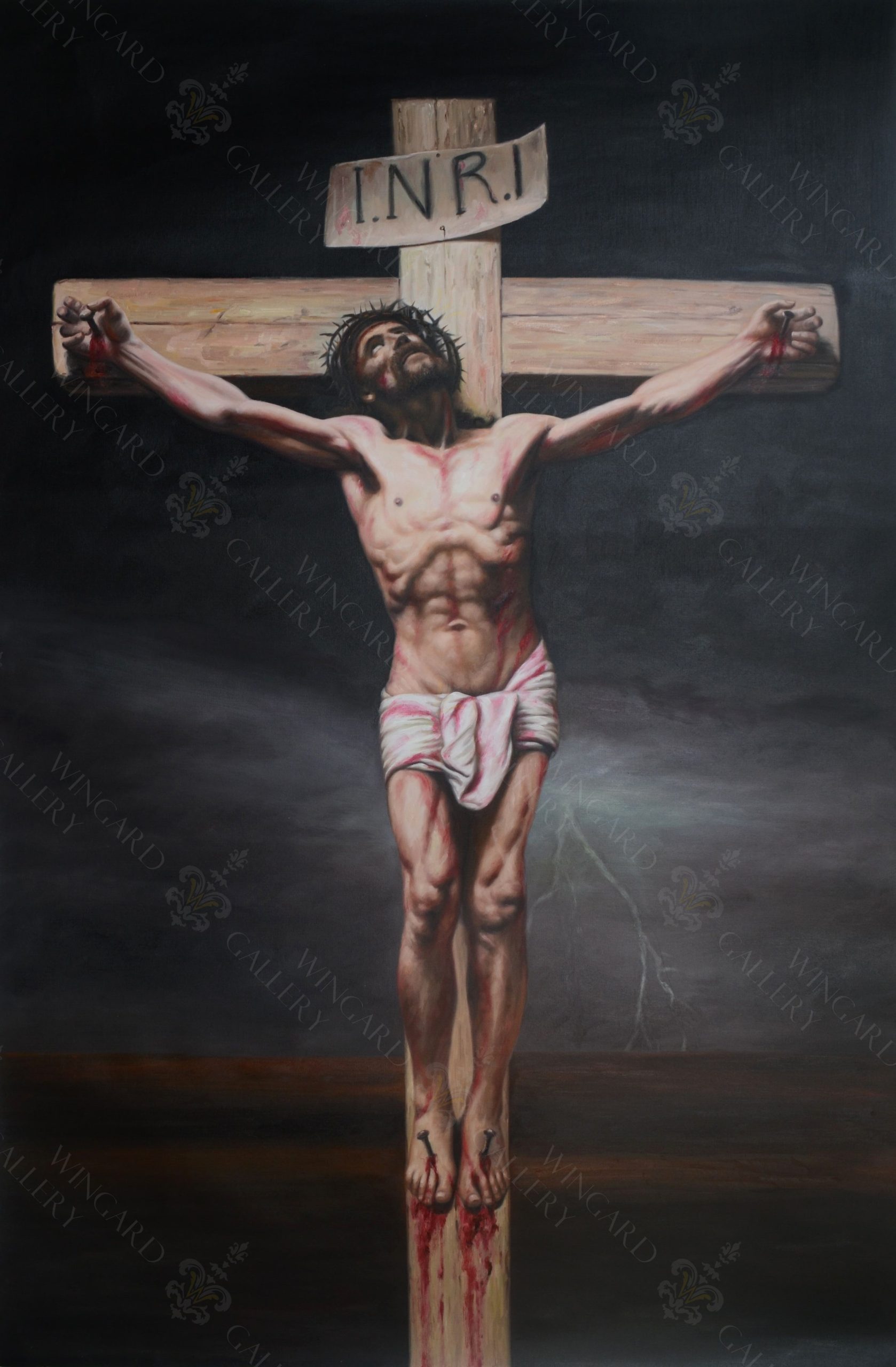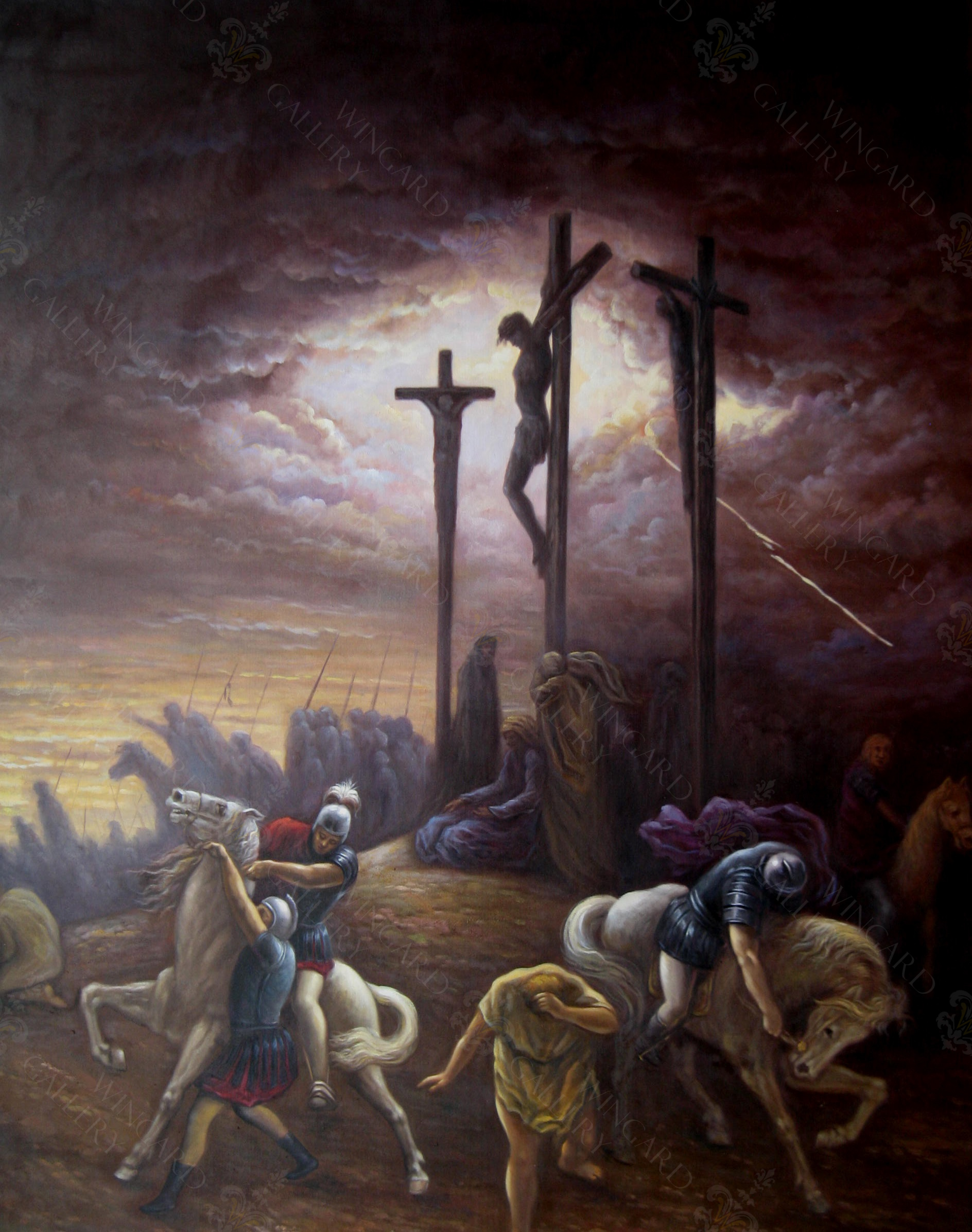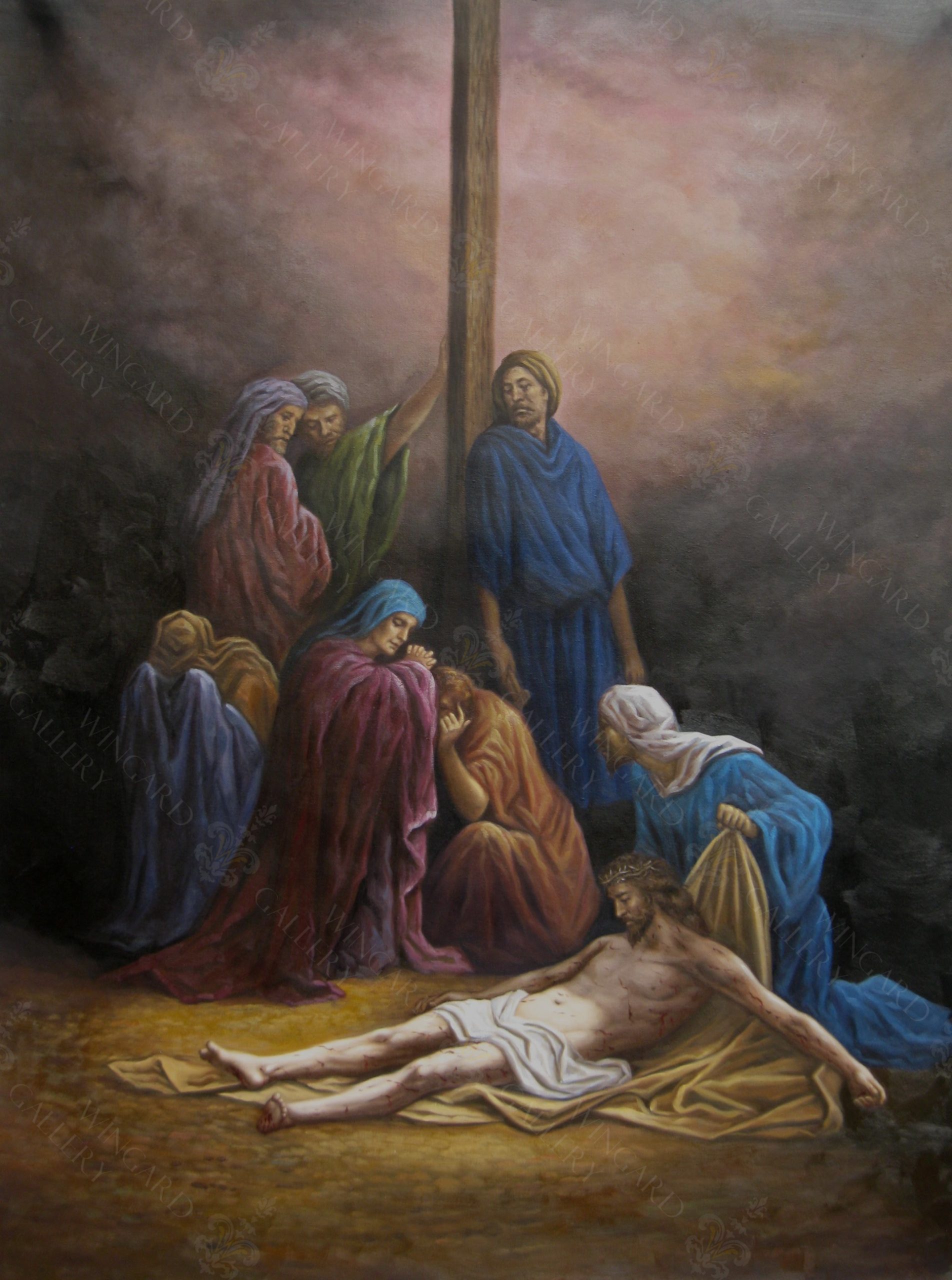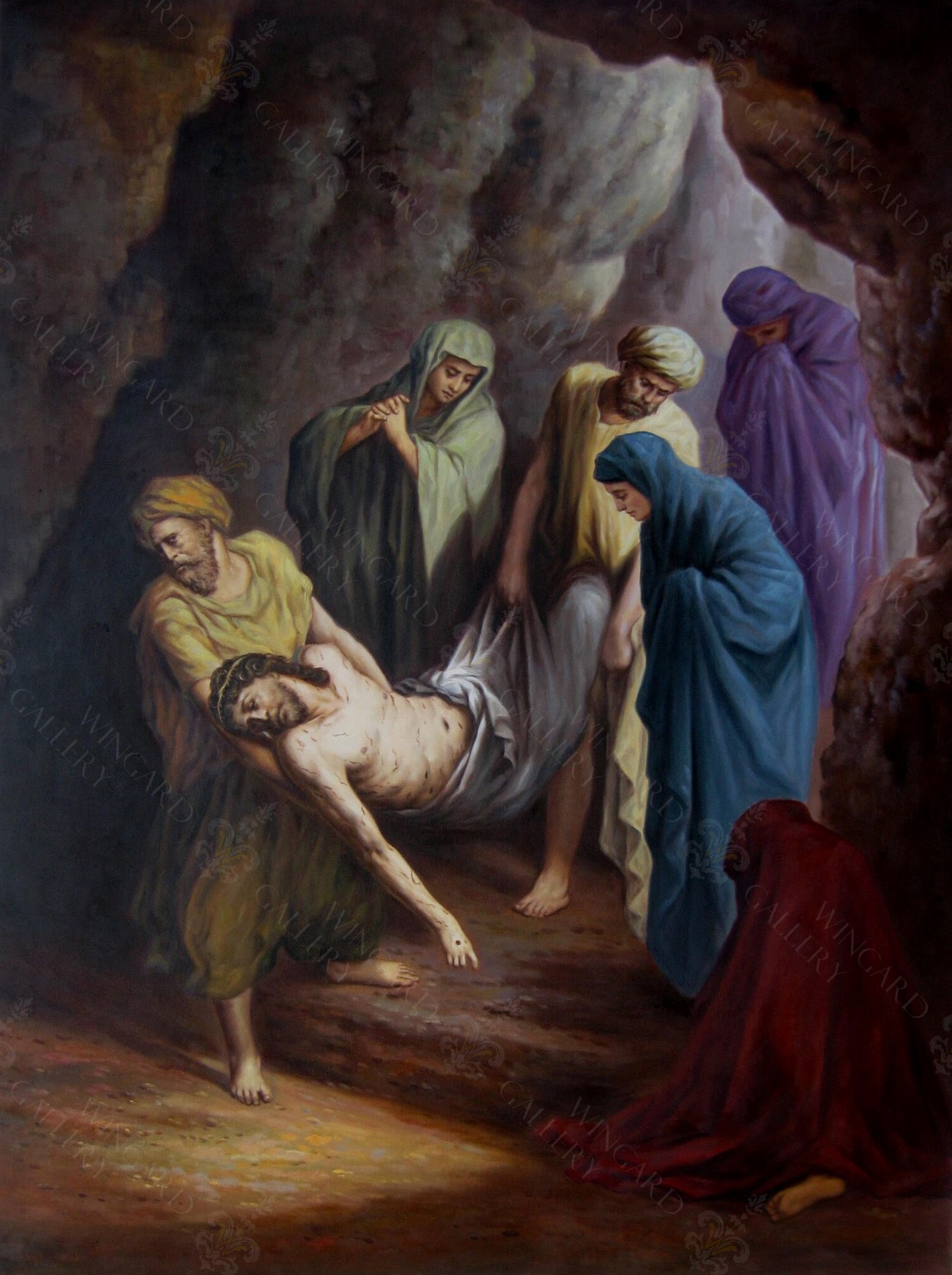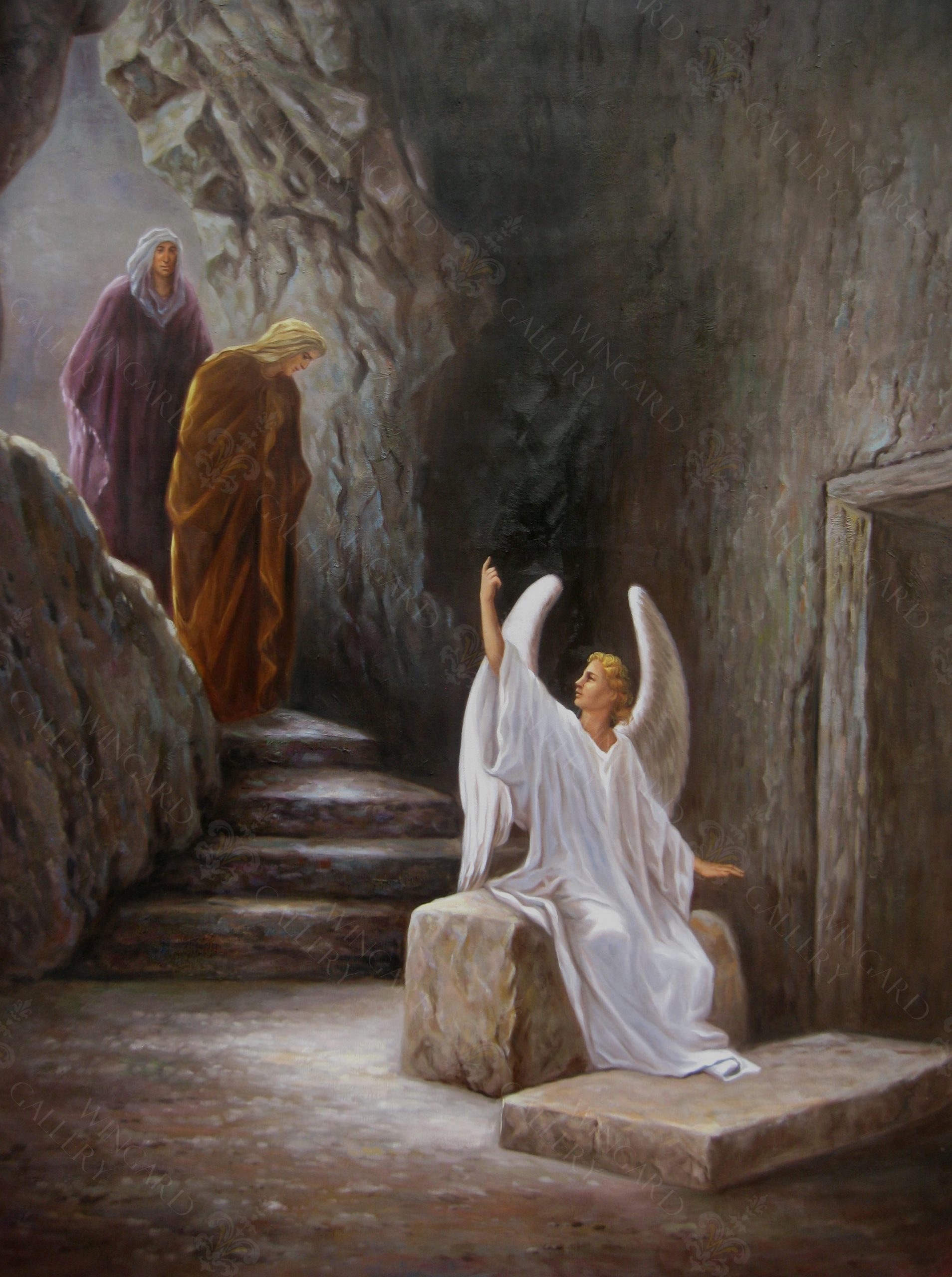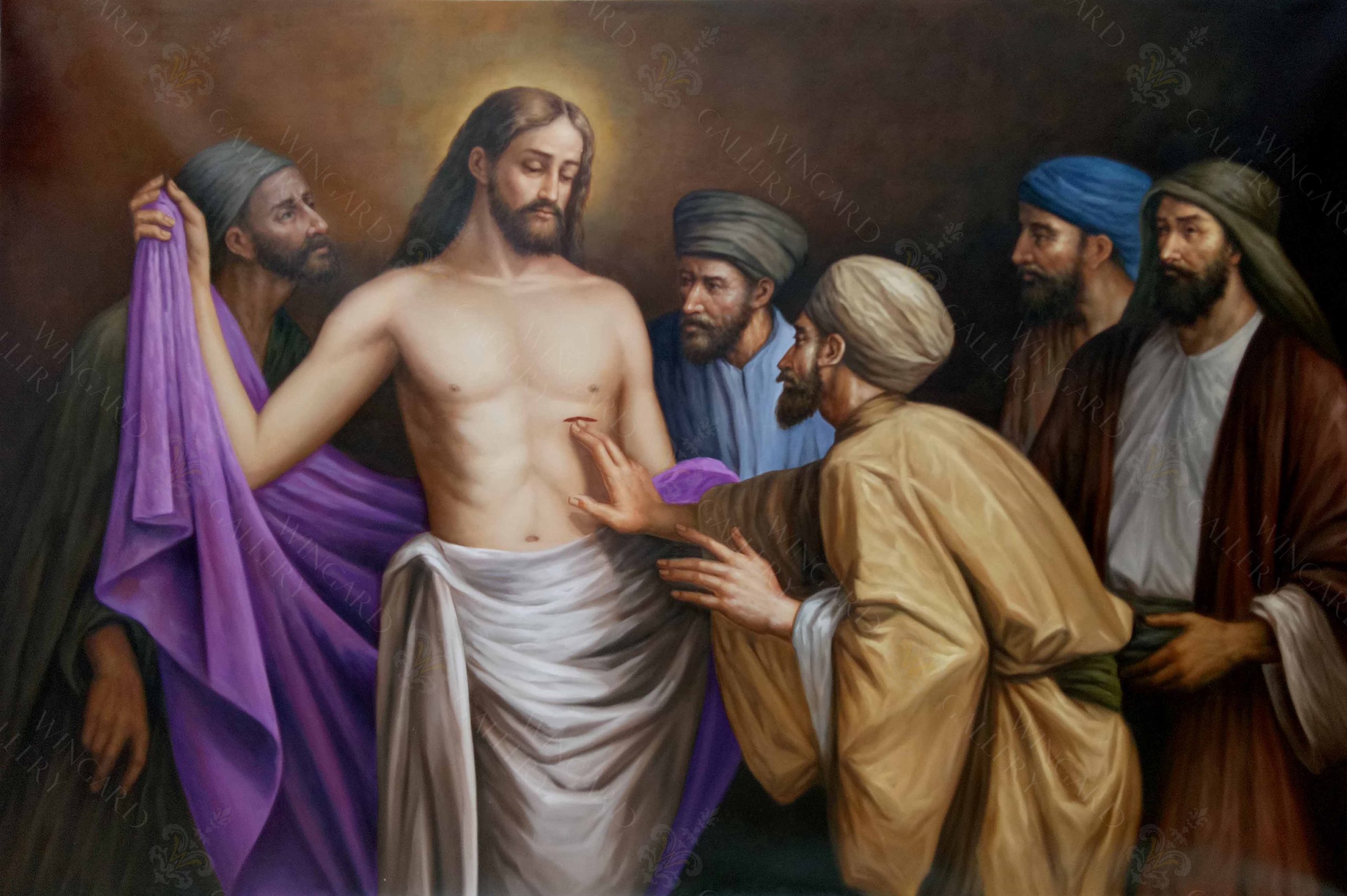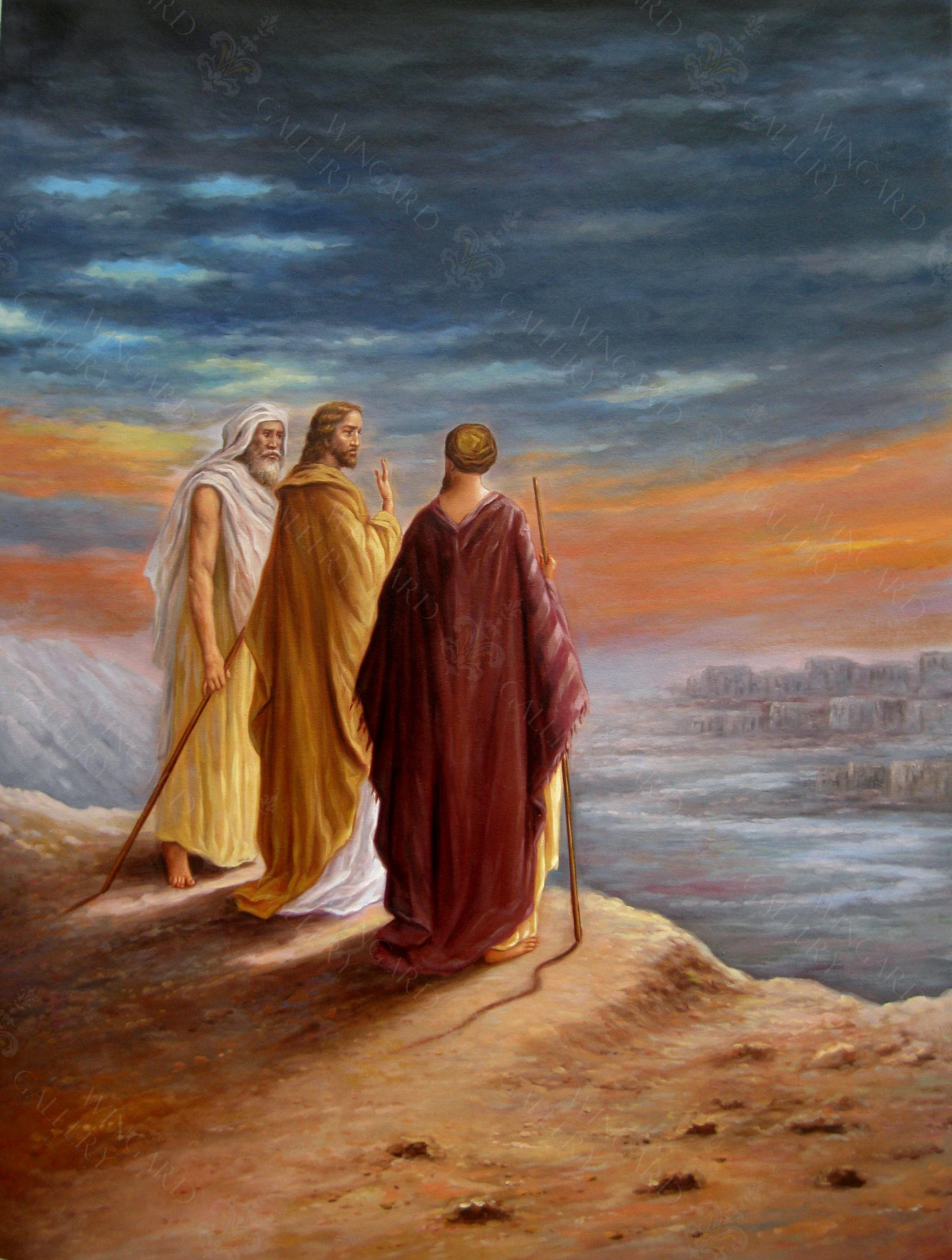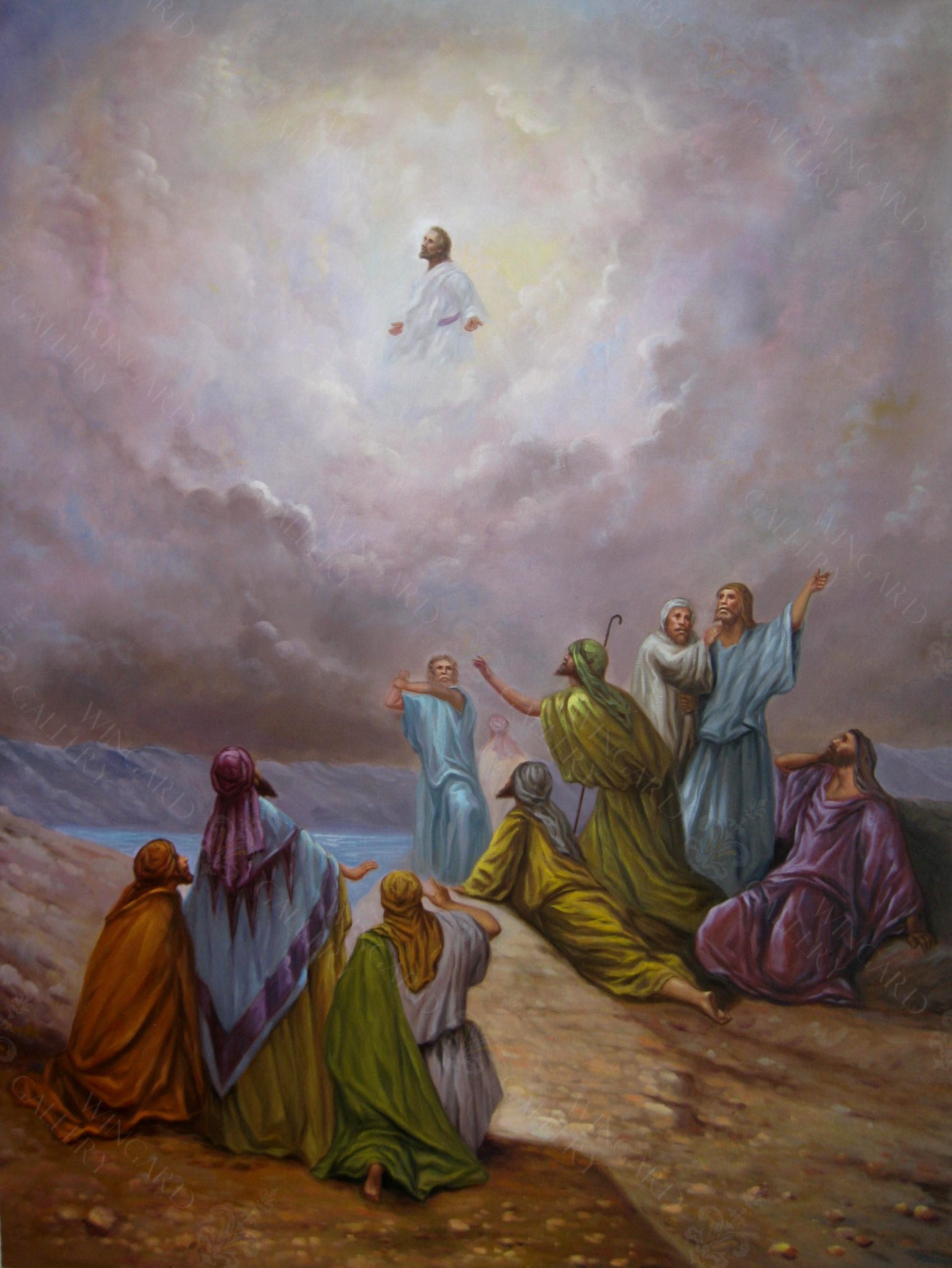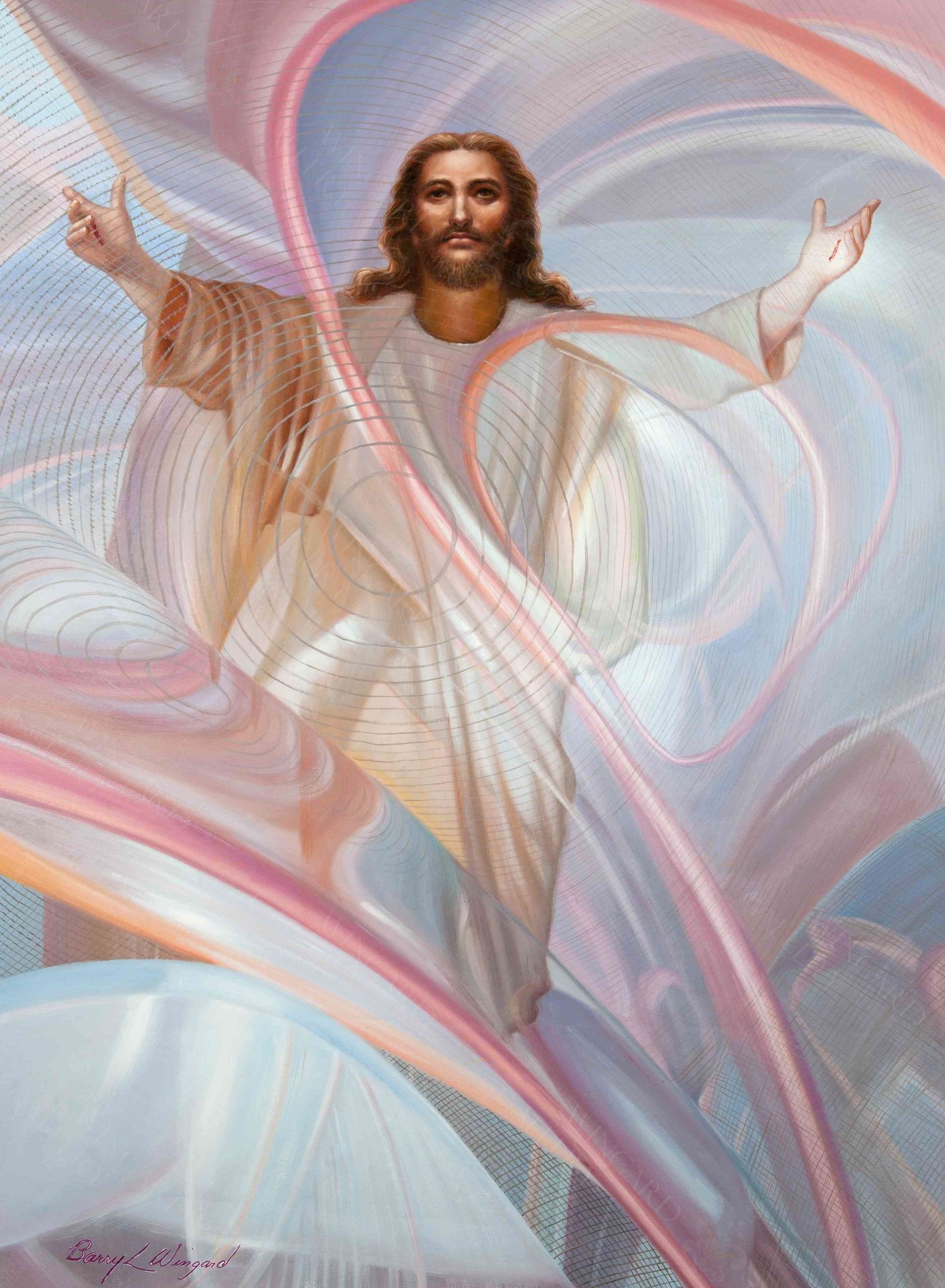The Passion
Triumphal Entry into Jerusalem (Matthew 21: 1-11,
Mark 11: 1-11 Luke 19:28-44 and John 12:12-19)
The Triumphal Entry into Jerusalem, described in the Gospels, marks Jesus’ arrival before his crucifixion. In each Gospel, Jesus rides into Jerusalem on a colt, while people spread cloaks and palm branches, shouting praises. This event fulfills prophecies and sets the stage for Jesus’ final week. Our collection honors Jesus’ life, faith, and love. Experience the profound and captivating Passion, Burial, and Resurrection through these artworks. Don’t miss the chance to bring this timeless message into your home or church as an original or print, finding hope and meaning in Jesus’ sacrifice and the enduring power of His love.
The Last Supper (John 13:1-32)
Experience the power and emotion of the Last Supper with this remarkable painting. Every brushstroke brings the scene to life, capturing the solemnity and significance of this pivotal moment in Christian history. The depth of emotion and profound symbolism contained within this artwork will leave a lasting impression on your heart. Displaying “The Last Supper” in your home or place of worship not only adds a touch of artistic beauty but also serves as a powerful reminder of the sacrificial love that Jesus exemplified. Let this painting be a visual representation of divine love that continues to inspire believers.
Jesus Washing Disciples Feet
Experience the humility and love of Jesus depicted in “The Foot-Washing”: A profound painting capturing the essence of servant leadership. This artwork portrays the powerful moment when Jesus humbly washes the feet of His disciples, teaching them the importance of humility, service, and love for others. Each brushstroke conveys the depth of emotion and significance of this transformative act. Displaying “The Foot-Washing” in your home or place of worship serves as a constant reminder to emulate Jesus’ example of selflessness and compassion. Let this painting inspire you to serve others with a humble heart and make a lasting impact in the world.
Disciples Sleeping in Garden of Gethsemane
Experience the poignant moment of the disciples sleeping in the Garden of Gethsemane in “The Disciples’ Slumber”: A painting that portrays the human frailty and lack of understanding during Jesus’ darkest hours. Each brushstroke captures the disciples’ vulnerability and Jesus’ unwavering faith. Displaying “The Disciples’ Slumber” serves as a reminder of our own imperfections and the need for redemption. It prompts reflection on the depth of Jesus’ sacrifice and the enduring power of His love. Let this artwork inspire you to seek understanding, grow in faith, and appreciate the magnitude of Jesus’ journey.
Agony in the Garden (Luke22:41-44)
Experience the profound anguish of Jesus in “The Agony in the Garden”: A painting that captures the intensity of his prayer and inner struggle before his crucifixion. Each brushstroke portrays his emotional turmoil and unwavering submission to God’s will. As Jesus sweats drops of blood, the weight of his sacrifice becomes palpable. Displaying “The Agony in the Garden” serves as a reminder of Jesus’ immense love and the depth of his sacrifice for humanity. Let this artwork inspire reflection, gratitude, and a renewed appreciation for the enduring power of His love.
The Kiss of Judas (Mark 14:43-47)
Experience the poignant moment of “The Kiss of Judas” painting: A depiction of betrayal and the beginning of Jesus’ trial and crucifixion. Judas Iscariot’s kiss, a gesture of greeting turned act of betrayal, signifies the moment when Jesus was identified and seized by the authorities. This event, rooted in prophecy, carries profound significance in Christian theology. The painting captures the depth of betrayal and the path that leads to Jesus’ ultimate sacrifice. Display this artwork to reflect on the complexities of human nature, redemption, and the enduring power of Jesus’ love. Let it serve as a reminder of the journey that unfolds towards salvation.
Peter Denies Knowing Jesus (John 18:15-18, 25-27)
Experience the powerful moment of Peter’s Denial in this painting. Witness Peter’s struggle as he denies his association with Jesus three times in the courtyard, just as Jesus had predicted. The painting captures Peter’s anguish and remorse as he realizes the gravity of his actions. This event reminds us of the complexities of human weakness and the need for redemption. Display this artwork as a reminder of the transformative power of forgiveness and the potential for growth even in moments of profound failure. Let it inspire reflection on our own shortcomings and the possibility of renewal through faith and grace.
Jesus Is Crowned with Thorns (Matthew 27:29 or John 19:2-3)
Witness the powerful depiction of “Jesus Crowned with Thorns” in this painting. The artwork captures the moment of mockery and humiliation as Roman soldiers twisted a crown of thorns and placed it on Jesus’ head. The purple robe and sarcastic gestures reinforce their mocking of Jesus’ claim to be the King of the Jews. This act symbolizes the immense suffering and sacrifice Jesus endured for humanity’s sins. Display this painting as a reminder of Jesus’ unwavering love and his willingness to endure humiliation for the redemption of all. Let it inspire reflection on the depth of his sacrifice and the transformative power of his love.
Jesus Is Scourge (Mark 15:19 or John 19:1
Experience the gripping portrayal of “Jesus Scourged” in this painting. The artwork vividly captures the brutal and painful ordeal of Jesus being whipped and beaten by Roman soldiers. Stripped and tied to a post, He endures the merciless scourging, a cruel act of punishment and humiliation. The soldiers further mock Him by adorning Him with a crown of thorns and a purple robe. This depiction serves as a powerful reminder of the immense suffering Jesus endured for humanity’s redemption. Display this painting as a testament to His sacrifice and let it inspire contemplation on the depth of His love and the transformative power of His sacrifice.
Jesus is Mocked (Matthew 27:27-31)
Behold the striking painting of “Jesus Mocked” from the biblical account in Matthew 27:27-31. Witness the cruel and degrading treatment inflicted upon Jesus by the Roman soldiers. Stripped of His clothes, a scarlet robe draped over His shoulders mockingly, and a twisted crown of thorns pressed onto His head, they taunt Him as the “King of the Jews.” The soldiers spit on Him, strike Him with a reed, and jeer at His claims. This poignant portrayal captures the depth of Jesus’ suffering and the mockery He endured for the sake of humanity. Display this painting as a reminder of His sacrificial love and the triumph of His enduring spirit.
Jesus Is Presented to the People (John 19:12-16)
Witness the dramatic painting capturing the moment when Jesus is presented to the people by Pontius Pilate, the Roman governor, as described in John 19:12-16. Pilate, torn between Jesus’ innocence and the demands of the crowd, reluctantly presents Him, declaring, “Behold your King!” The crowd, driven by religious fervor and political pressure, rejects Jesus and demands His crucifixion. This pivotal moment showcases the clash of power, faith, and human nature, leading to Jesus’ ultimate sacrifice on the cross. Display this painting as a reminder of the complexities of justice, loyalty, and the profound love demonstrated by Jesus in His final hours.
Jesus Arrives at Calvary (Luke 23:26-32)
Witness the poignant painting depicting Jesus’ journey to Calvary as described in Luke 23:26-32. As Jesus, weakened and burdened, struggles to carry his cross, Simon of Cyrene is compelled to assist him by the soldiers. A crowd of mourners follows, but Jesus, in his compassion, redirects their focus, urging them to mourn for themselves and their children. He speaks of the impending judgment and the need for repentance. At Calvary, Jesus is crucified alongside criminals, marking a pivotal moment in Christian belief—the sacrificial death of Jesus for the forgiveness of sins. Contemplate the depth of Jesus’ suffering and the call to transformation through this powerful painting.
Jesus Falls with the Cross (Mark 15:21-22)
Experience the profound painting depicting Jesus’ journey to Golgotha, as described in the Gospel of Mark. As Jesus bears the weight of the cross, his physical and emotional suffering becomes evident. Along the way, Simon of Cyrene is compelled to help Jesus carry the burden. Arriving at Golgotha, Jesus stumbles and falls, emphasizing his human vulnerability and the immense sacrifice he willingly undertakes. This event symbolizes his suffering and willingness to endure for the redemption of humanity. Reflect on the significance of Jesus’ falls during his crucifixion, an integral part of Christian theology, during the observance of Lent and Holy Week.
Jesus Is Nailed to the Cross (John 19:17-18)
The crucifixion of Jesus is a pivotal event in Christianity, symbolizing His sacrificial death for the forgiveness of sins. In John 19:17-18, Jesus is taken to Golgotha, the Place of a Skull, where he is nailed to the cross between two criminals. The crucifixion was a brutal Roman execution method involving the nailing of the victim to a wooden cross. This event fulfilled prophecies and represents Jesus’ ultimate sacrifice for humanity’s redemption. Through this powerful artistic depiction, experience the profound meaning of Jesus’ crucifixion and find hope and inspiration in his enduring love and resurrection.
The Cross Is Lifted Up (Luke23:32-33 or Matthew 27:32-38)
The crucifixion scene captures the pivotal moment when Jesus is nailed to the cross and lifted up at Golgotha. This act of brutal execution, as described in Luke 23:32-33 and Matthew 27:32-38, holds deep theological significance. Jesus willingly offered himself as a sacrifice for humanity’s sins, fulfilling God’s plan for salvation. It symbolizes his immense love and redemption, forming the foundation of Christian faith. The depiction of this moment in art allows observers to experience the profound meaning of Jesus’ sacrifice and find hope in his enduring love. Don’t miss the opportunity to bring this powerful painting into your home or church and be moved by its timeless message.
The Death of Jesus (Matt 27:45-54 or Luke 23:34-43)
The death of Jesus on the cross hold’s immense significance in Christian theology. Two accounts in the Bible, Matthew 27:45-54 and Luke 23:34-43, describe different aspects of this event. In Matthew, darkness covers the land, Jesus cries out, and the temple curtain is torn. In Luke, Jesus forgives his executioners and promises paradise to a repentant criminal. These accounts symbolize Jesus’ sacrifice for humanity’s sins, the removal of barriers between God and humanity, and the offer of redemption and eternal life. This painting captures the profound and captivating depiction of Jesus’ death, reminding viewers of his faith, sacrifice, and enduring love.
The Crucifixion
The Crucifixion is a pivotal event in Christian belief, symbolizing Jesus’ sacrifice for humanity’s redemption. The Gospels, including Matthew, Mark, Luke, and John, provide accounts of Jesus’ arrest, trial, and crucifixion. These narratives depict Jesus carrying the cross, being nailed to it, and his death. Each Gospel highlights different details, such as Simon of Cyrene helping Jesus, the presence of two criminals, the darkness that fell, and Jesus’ last words. The Crucifixion represents Jesus’ atonement for sins and the promise of eternal life. This painting captures the profound and captivating depiction of Jesus’ sacrifice and invites viewers to reflect on its timeless message of faith, love, and sacrifice.
Darkness pierced at the Crucifixion (Luke 23:44-46)
The painting depicts the significant events of Jesus’ crucifixion described in Luke 23:44-46. It portrays the darkness that covered the land from noon to three in the afternoon, symbolizing the weight and sorrow of Jesus’ sacrifice. The tearing of the temple curtain represents the removal of the barrier between God and humanity through Jesus’ death. Jesus’ final words, committing his spirit to God, show his trust and surrender. This painting captures the profound meaning of Jesus’ sacrifice and invites viewers to reflect on the transformative power of his love. Bring this artwork into your home or church to experience its timeless message.
Jesus’ Body Is Taken Down (Mark 15:42-46)
The painting depicts the significant event of Jesus’ body being taken down from the cross and placed in a tomb, as described in Mark 15:42-46. It portrays Joseph of Arimathea, a respected council member, boldly requesting Jesus’ body from Pilate and carefully taking it down from the cross. Joseph then wraps Jesus’ body in linen cloth and lays it in a new tomb. This act of burial demonstrates respect for Jesus and fulfills prophecies. It also prepares the way for Jesus’ resurrection, symbolizing his triumph over death. This painting captures the solemnity and significance of Jesus’ burial and invites reflection on the hope of resurrection.
The Dead Jesus (John 19:40)
The painting portrays the significant moment of Jesus’ body being prepared for burial, as described in John 19:40. The body of Jesus is shown being wrapped in linen cloths, following the burial customs of the Jewish people. The inclusion of spices highlights the care and respect given to Jesus’ body. This act of burial signifies the conclusion of Jesus’ earthly life and sets the stage for the subsequent events, such as his resurrection. The painting invites viewers to reflect on the solemnity and significance of Jesus’ burial, as well as the hope and transformative power of his resurrection.
The Burial of Jesus (John 19:41-42
The painting depicts the solemn moment of Jesus’ burial, as described in John 19:41-42. The scene shows Joseph of Arimathea and Nicodemus carefully placing Jesus’ body in a new tomb located in a nearby garden. The significance of this event is conveyed through the symbolism of the garden, representing new life and the fulfillment of prophecies. The use of a new tomb emphasizes Jesus’ uniqueness and separation from ordinary individuals. The painting invites viewers to reflect on the conclusion of Jesus’ earthly life and the anticipation of the miraculous events that would follow, culminating in his resurrection.
The Angel at the Empty Tomb (Matthew 28:1-8)
The painting portrays the powerful moment of the angel appearing at the empty tomb, as described in Matthew 28:1-8. The scene captures the awe-inspiring presence of the angel, shining like lightning, rolling away the stone, and sitting on it. The women, Mary Magdalene and the other Mary, are depicted with a mixture of fear and joy as they encounter the angel and receive the news of Jesus’ resurrection. The painting invites viewers to reflect on the transformative impact of this event, symbolizing the triumph of life over death and the fulfillment of Jesus’ promise. It serves as a reminder of hope, redemption, and the enduring power of faith in the Christian tradition.
Doubting Thomas (John 20:24-29)
The painting portrays the iconic moment of Doubting Thomas encountering Jesus and touching his wounds, as described in John 20:24-29. Thomas is depicted with a mix of skepticism and astonishment as he reaches out to verify Jesus’ resurrection. Jesus, radiating compassion, offers Thomas the evidence he sought, while also emphasizing the importance of faith. The painting invites viewers to reflect on the relationship between doubt and belief, highlighting the transformative power of encountering truth and the blessedness of faith without physical proof. It serves as a reminder to embrace and reconcile our doubts, leading to a deeper understanding and acceptance of the divine.
The Miraculous Catch of Fish (John 21:1-8)
The painting depicts the scene of the Miraculous Catch of Fish, with Jesus standing on the left. The disciples’ fishing boat is shown on the Sea of Galilee, symbolizing their efforts and struggles. Jesus, unrecognized at first, guides them to cast their net on the right side of the boat, resulting in an abundant catch. The painting captures the disciples’ astonishment and realization of Jesus’ presence and power. It represents the divine intervention and provision, reinforcing the disciples’ faith and commitment to Jesus’ mission. The scene conveys the transformative encounter with Jesus and the affirmation of His resurrection.
Jesus and Two Disciples Going to Emmaus (Luke 24:13-32)
The painting portrays the scene of Jesus and two disciples on the road to Emmaus. Jesus is shown walking alongside the disciples, engaging in conversation with them. The disciples appear surprised and unaware of Jesus’ identity. The artwork symbolizes the importance of Scripture in recognizing the presence of Jesus and experiencing spiritual revelation. It conveys the transformative encounter with the resurrected Christ and the disciples’ response to share the good news.
Ascension of Christ (Luke 24:50-53)
The painting portrays the scene of the Ascension of Christ. Jesus is depicted ascending into heaven, surrounded by a radiant light or cloud. His disciples are shown looking up in awe and wonder as they witness His departure. The artwork captures the significance of this event, symbolizing Jesus’ return to the presence of God the Father after completing His mission on earth. It represents the fulfillment of divine prophecy, the exaltation of Jesus, and the anticipation of His eventual return. The painting invites viewers to contemplate the transcendence of Christ and the hope of His promised coming.
The Resurrected Christ
The Resurrected Christ is depicted in this painting, symbolizing Jesus’ victory over death and his resurrection from the grave. The artwork captures the transformative moment when Jesus emerged from the tomb, radiating divine light and life. His resurrected body is depicted with wounds from the crucifixion, signifying the continuity between his earthly suffering and his triumph over death. The painting evokes a sense of awe, hope, and joy, inviting viewers to contemplate the profound significance of the resurrection and its implications for their faith. It serves as a powerful reminder of the central message of Christianity and the eternal hope found in Christ’s resurrection.

